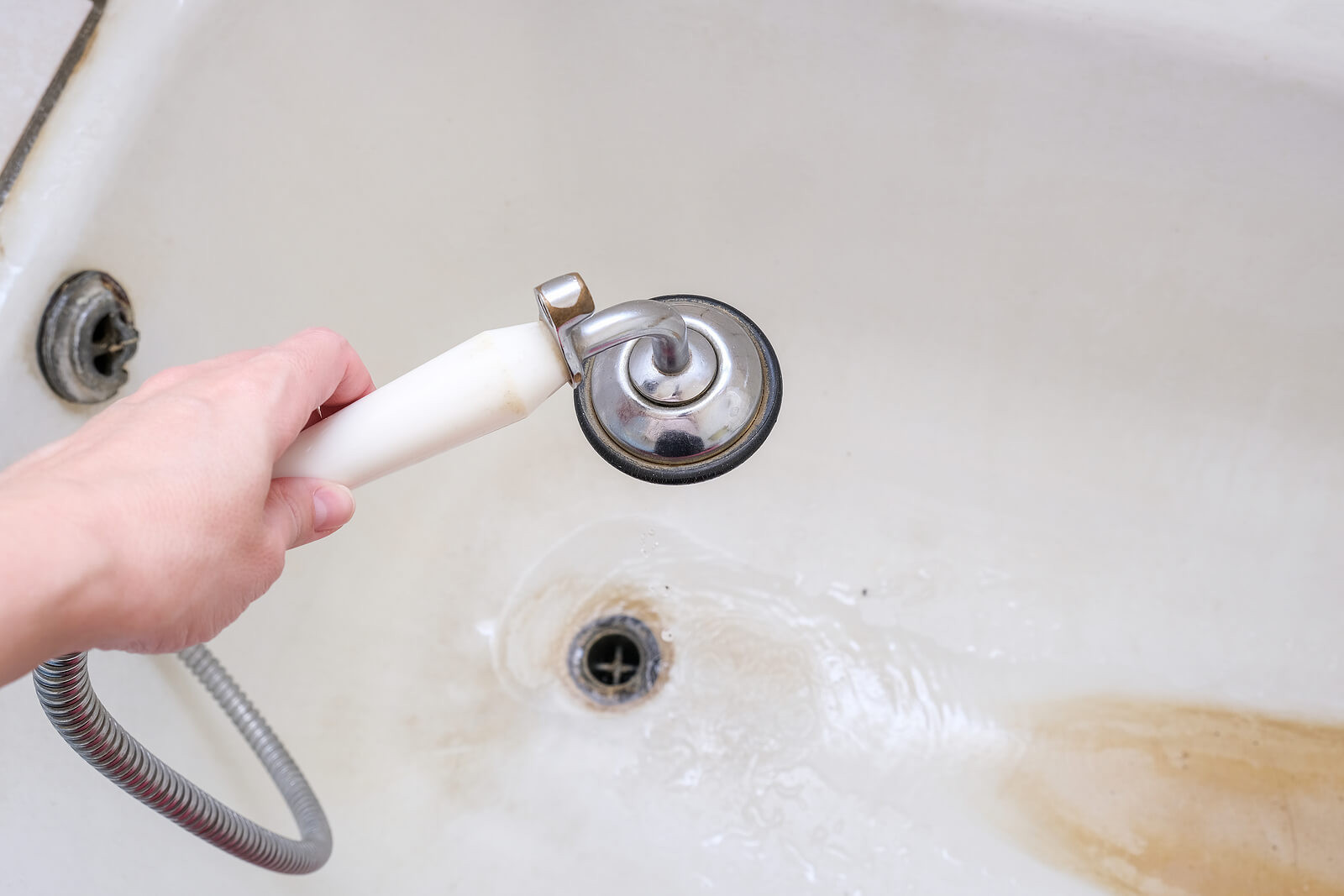Yellow stains in bathtubs are often caused by hard water mineral deposits or soap scum buildup. Rust from old pipes can also contribute to discoloration.
Tackling the mystery behind unsightly yellow stains in your bathtub is crucial for maintaining a clean and inviting bathroom. Various factors lead to these blemishes on your tub’s surface; recognizing the causes is the first step towards effective cleaning and prevention.
Hard water, which contains high levels of minerals like calcium and magnesium, leaves behind a residue that can manifest as yellowish stains over time. These stains may not only look unpleasant but can also become stubborn to remove if not addressed promptly. In addition to mineral deposits, the use of oily bath products and insufficient ventilation can result in soap scum accumulation, further contributing to the yellowing of your bathtub. Regular cleaning and water treatment can help keep your tub stain-free and hygienic.

Credit: m.youtube.com
Introduction To Bathtub Discoloration
Bathtub discoloration often sneaks up, unnoticed. It starts subtly, transforming a clean, shiny tub into a less appealing bathroom centerpiece. Yellow stains signal more than just a cosmetic issue; they may indicate underlying problems. Understanding the causes of these yellow stains is key to maintaining a pristine tub.
Initial Signs Of Yellow Stains
A once white bathtub may show early signs of yellowing. These signs can include small, scattered spots or a faint, overall tinge. Bright bathroom lighting often highlights these initial changes. Spotting these early can prevent more stubborn stains.
Common Concerns With Bathtub Appearance
- Water Quality: Hard water leaves behind minerals that can stain.
- Product Residue: Soaps and cleaners may contribute to discoloration.
- Mildew Growth: Damp conditions encourage mildew that stains surfaces.
- Age of Tub: Older tubs often show wear and tear as yellow stains.

Credit: www.reddit.com
Culprits Behind Yellow Stains
Discovering yellow stains in your bathtub can be frustrating. Let’s uncover the main culprits behind yellow stains. Knowing these can help you tackle the problem effectively.
Hard Water Deposits
Hard water contains high levels of minerals. These minerals, like calcium and magnesium, stick to surfaces. Over time, they create yellow or brownish stains. Regular cleaning reduces these deposits. A water softener system might prevent them.
Iron And Rust Infiltration
Old pipes sometimes rust. This rust mixes with water. When the water sits in the tub, it leaves behind yellow or orange stains. Replacing old pipes and using rust removers can help.
Soap Scum Buildup
Soap mixes with hard water, forming soap scum. This scum sticks to the tub, turning yellow over time. Cleaning regularly with the right products prevents buildup.
- Use vinegar and baking soda for natural cleaning.
- Commercial cleaners target hard water and soap scum.
- Rust removers are effective for iron stains.
The Role Of Cleaning Products
The Role of Cleaning Products plays a pivotal part in maintaining the pristine look of bathtubs. Yet, certain products may contribute to unsightly yellow stains. Understanding the interaction between cleaners and bathtub materials is crucial for a spotless bathroom.
Chemical Reactions Causing Stains
Not all cleaning agents are gentle on bathtub surfaces. Some chemicals in these products react with the material of the tub, especially with acrylic and enamel. This reaction can leave behind yellow stains that are hard to remove. Here’s a breakdown of common culprits:
- Bleach: Surprisingly, bleach can cause yellowing on lighter tubs.
- Abrasive Powders: These can erode the finish, leading to stains.
- Hard Water: Minerals in the water react, leaving behind residue.
Choosing The Right Cleaners
Selecting the correct cleaning products is essential to prevent staining. Look for cleaners labeled ‘non-abrasive’ and ‘gentle’. Here are some safe options:
| Type | Examples |
|---|---|
| Liquid Cleaners | Mild dish soap, vinegar solution |
| Non-Abrasive Gels | Bathroom-specific gels |
| Natural Cleaners | Baking soda paste, lemon juice |
Always test a small area first. Follow up with regular maintenance to keep your bathtub stain-free and shining.
Natural Factors
Understanding the natural factors that cause yellow stains in bathtubs is essential. These factors can affect the cleanliness and appearance of a bathtub. Let’s explore two key natural causes: bacteria growth and sunlight exposure.
Bacteria And Microorganism Growth
Warm, moist environments are perfect for bacteria. Bathtubs often provide these conditions. Bacteria can thrive unseen, leading to yellow stains. Regular cleaning helps prevent these unsightly marks.
- Organic debris: Soap scum and body oils create a food source for bacteria.
- Stagnant water: Pools of water left in the tub can harbor microorganisms.
- Infrequent cleaning: Without regular washing, bacteria multiply, causing discoloration.
Effects Of Sunlight Exposure
Direct sunlight can bleach many materials. However, with bathtubs, the effect can be the opposite. Prolonged exposure to sunlight can break down the material of the tub, leading to yellowing.
| Material | Reaction to Sunlight |
|---|---|
| Acrylic | May discolor over time |
| Porcelain | Less prone but still vulnerable |
| Fiberglass | Can yellow with UV exposure |
Using curtains or blinds can shield bathtubs from sunlight. This simple step can keep your tub looking new.
Effective Home Remedies
Yellow stains in your bathtub can be unsightly and frustrating. Luckily, there are effective home remedies to help you get rid of them. These methods are not only easy but also use items you likely already have at home. Let’s dive into some of the best solutions to restore the shine to your bathtub.
Baking Soda And Vinegar
This combination is a powerful cleaner for many areas of your home, including the bathtub. Here’s how to use it:
- Mix one part baking soda with two parts vinegar.
- Spread the mixture on the yellow stains.
- Let it sit for 30 minutes.
- Scrub gently with a sponge and rinse.
Lemon And Salt Scrub
Lemon and salt work together to break down stains naturally. Follow these steps:
- Slice a lemon in half and dip it in salt.
- Scrub the stained area with the lemon.
- Leave it for about 15 minutes.
- Rinse the area well with water.
Borax And Hydrogen Peroxide
For tougher stains, this mixture can work wonders. Here’s what to do:
- Create a paste with equal parts borax and hydrogen peroxide.
- Apply the paste to the stains.
- Allow it to sit for 30 minutes.
- Scrub gently and then rinse off.
These home remedies are not only effective but also safe and environmentally friendly. With regular cleaning, you can keep your bathtub looking bright and stain-free.
Commercial Solutions
When it comes to removing yellow stains from bathtubs, commercial solutions offer powerful options. These products are designed to tackle various types of stains effectively. Let’s dive into some of the commercial cleaners that can restore the sparkle to your bathtub.
Specialized Bathtub Cleaners
Specialized bathtub cleaners are readily available in stores. They often contain a blend of ingredients tailored for bathroom surfaces. Many of these cleaners work well for daily maintenance and stain prevention. Here’s a list of benefits these cleaners provide:
- Easy to use with clear instructions
- Safe for various bathtub materials
- Formulated to minimize scrubbing
Oxidizing Agents For Tough Stains
For more stubborn stains, oxidizing agents like bleach or hydrogen peroxide can be the answer. These powerful substances break down stains through a chemical reaction. They are particularly good at dealing with tough yellow stains. Remember to use them safely:
| Product | Usage | Safety Tip |
|---|---|---|
| Bleach | Mix with water | Ventilate area |
| Hydrogen Peroxide | Apply directly | Wear gloves |
Ensure you follow the product’s directions for the best results. Keep these agents away from children and pets.
Preventive Measures
Keeping a bathtub sparkling can be a challenge. Yellow stains can turn a clean bathroom into a dingy space. To prevent these unsightly marks, consider these effective strategies.
Regular Cleaning Schedules
Maintaining a routine cleaning schedule is crucial. Dirt and residue build up over time. Regular cleaning prevents stain formation.
- Weekly Scrubbing: Use a gentle cleaner and a soft sponge.
- Rinse After Use: Quick rinses wash away immediate dirt.
- Deep Clean Monthly: Dedicate time for a thorough cleaning.
Water Softening Techniques
Hard water contributes to yellow stains. Water softening techniques can help.
| Technique | Benefits |
|---|---|
| Water Softener Installation | Reduces mineral deposits, prevents staining |
| Vinegar Solution | Natural way to break down residues |
Water softeners can be a wise investment. They protect the entire plumbing system.
Professional Cleaning Services
Battling stubborn yellow stains in your bathtub can be frustrating.
Professional cleaning services offer the expertise and tools required to tackle these challenges.
They use specialized products and techniques that are often beyond the reach of typical household cleaning supplies.
Let’s dive into when it’s time to call in the experts and weigh the cost against the benefits.
When To Call The Experts
It’s time to call professional cleaners when:
- Home remedies fail to remove the stains.
- Stains return quickly after cleaning.
- Discoloration spreads or worsens.
- You notice unpleasant odors that don’t dissipate.
Experts possess the right skills to restore your bathtub’s shine without damaging the surface.
Cost Versus Benefits
| Cost | Benefits |
|---|---|
| Initial investment higher than DIY | Long-term savings on supplies and repairs |
| Varies based on stain severity | Expertise ensures complete stain removal |
| Depends on bathtub material and size | Preserves bathtub integrity and appearance |
The upfront cost of a professional service might seem high.
Yet, it often leads to better outcomes and can prevent costly repairs or replacements down the line.
Trusting experts can ensure your bathtub remains a clean, inviting part of your home.
Restoration And Replacement
Yellow stains mar the beauty of a bathtub, calling for restoration or replacement. Over time, factors such as water minerals, soap scum, and rust contribute to these unsightly blemishes. While cleaning can help, sometimes the tub requires more drastic measures. This section explores options for breathing new life into your tub or deciding when to replace it.
Refinishing Options
Bathtubs can get a fresh, clean look with refinishing. This process involves cleaning, repairing, and recoating the surface. Professionals often use durable materials like acrylic or urethane for a glossy finish. Do-it-yourself kits are available, but professional services ensure longer-lasting results.
Benefits of refinishing:
- Cost-effective compared to replacement
- Extends the life of your tub
- Reduces landfill waste
Steps involved in refinishing:
- Surface cleaning and repair
- Application of primer and coating
- Final buffing and polishing
When To Consider Bathtub Replacement
At times, a bathtub is beyond repair. Cracks, leaks, and extensive damage are signs to consider replacement. A new tub can revitalize your bathroom and improve home value. Weigh the cost and disruption of replacement against the benefits.
Signs you need a new bathtub:
- Stubborn stains that don’t go away
- Visible cracks or structural damage
- Leakage issues
Replacement considerations:
| Factor | Detail |
|---|---|
| Cost | Higher initial investment than refinishing |
| Time | More time-consuming due to installation |
| Impact | Long-term solution with modern features |

Credit: www.waldmanplumbing.com
Frequently Asked Questions
Why Do Bathtubs Develop Yellow Stains?
Yellow stains in bathtubs are often caused by hard water, rust in the pipes, or residue from soap and shampoo. Regular cleaning can prevent staining.
Can Bleach Remove Bathtub Yellowing?
Bleach can be effective in removing yellow stains from bathtubs, but it should be diluted and used with caution to avoid damaging the tub’s surface.
Are Yellow Stains In Bathtubs Harmful?
Yellow stains themselves are not harmful, but they can indicate the presence of mold or mildew, which could pose health risks if not addressed.
How To Prevent Yellow Stains In Bathtubs?
Preventing yellow stains involves regular cleaning, using water softeners if dealing with hard water, and ensuring good ventilation to reduce moisture.
What Natural Remedies Clear Bathtub Stains?
Baking soda and vinegar can create a natural cleaning solution that is effective in removing yellow stains from bathtubs without harsh chemicals.
Conclusion
Wrapping up, understanding the causes behind yellow stains in your bathtub is key to keeping it sparkling clean. From mineral deposits to soap scum, tackling these issues early can prevent long-term damage. Regular cleaning and the right products are your best defense.
Keep your bathtub looking fresh and inviting with these simple tips.

